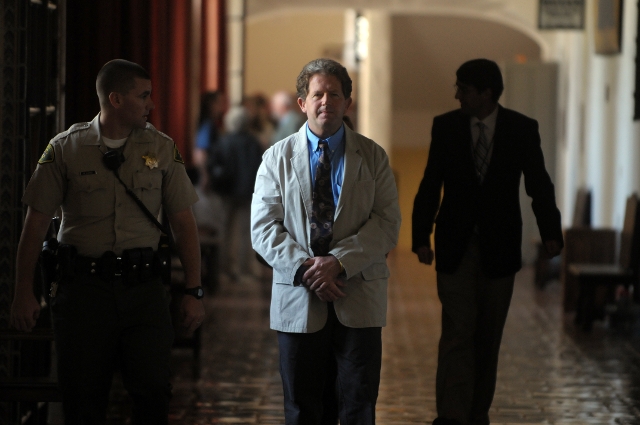DA Gets Lyons Conviction on Third Try
Jury Reaches Swift Verdict

Santa Barbara’s law enforcement community packed a courtroom today to hear the verdict in the Corey Lyons murder trial. After two mistrials, the second ending in a hung jury, the prosecution secured a stunningly swift verdict. The jury, selected in Solvang and bused in from North County every day, deliberated for only five hours. Judge Brian Hill accepted their decision only 24 hours after closing arguments ended.
Lyons was found guilty on two counts of murder with enhancements for financial gain, lying in wait, and committing multiple murders. Each enhancement makes Lyons eligible for life without parole. He was also found guilty of burglary. Sentencing is scheduled for February 7.
Police apprehended Lyons at 9 a.m. on the morning of May 4, 2009. His brother, Daniel, and Daniel’s partner, Barbara Scharton, had been shot to death in their weekend home on the Mesa at around 1:30 a.m. They lived in Fresno where Daniel worked during the week.
“Quite frankly, it’s time to end this case once and for all,” said defense attorney Robert Sanger in his closing argument. He questioned law enforcement’s investigation, including their collection of evidence, the integrity of the perimeter police formed around Daniel Lyons’s home after the shootings, and their scientific exactitude in examining the gunshot residue found on Corey Lyons.
Prosecuting attorney Ron Zonen, who had recently retired but tried this case at the urging of District Attorney Joyce Dudley, agreed that it was time to end the trial but interpreted the substantial yet largely circumstantial evidence quite differently than Sanger. He said in his own closing that it was “arrogant” of his opponent to call the police investigation shoddy.
Zonen contended that Lyons single-handedly killed the couple with three weapons. “There is no entry in Craigslist for assassin,” he told the jury during his rebuttal in an attempt to discount the possibility of an accomplice. Scharton was shot with a shotgun and .22 caliber gun, Daniel with a shotgun and .38 caliber gun. Aside from the difficulties of finding an accomplice, Zonen argued that Lyons was well motivated.
Later on the morning of May 4, he would have had to sign over a large chunk, if not most, of his assets — $100,000 and an undeveloped piece of property, along with another $150,000 within the next five years for which there would be a lien on his home — to his brother who had brought a lawsuit against him in 2008. Daniel sued Corey for a number of breaches, including worker’s compensation fraud after the latter — who worked as a contractor under the name Select Construction — built a weekend home for the former.
Daniel and Corey had not talked for 15 years previously, and apparently Daniel hired Corey as a form of reconciliation. The defense contended that Daniel set Corey up.
Unlike in previous trials, however, the prosecution did not focus on motive. Instead, Zonen focused on the evidence tying Lyons to the crime and establishing a timeline of his whereabouts during the night in question.
The prosecution also decided to go all-in on the importance of gunshot residue found on Corey, his gloves, and fanny pack. The defense argued strongly that residue particles could have been transferred to Corey from police officers, the police cruiser that transported the defendant to the station, or from the station itself. Therefore, the DA commissioned a study of the amount of particles present hanging around the police station on a day in which officers had been taking target practice in the basement firing range to prove that the number of particles on Corey’s hands was uncommonly high.

The quick conviction was a victory for the Santa Barbara law enforcement community, whose public image has taken some hits this past year. The same judge presiding over the Lyons case threw out a high-profile DUI case against investigative journalist Peter Lance, who accused his arresting officer of several improprieties including using pre-filled blood test waiver forms. The city has hired investigators to review those accusations. The police department is also facing scrutiny over the arrest of Tony Denunzio, a DUI suspect who some witnesses said was the victim of brutality. The DA did not charge Denunzio with resisting arrest or the arresting officer of using excessive force.
The large turnout of law enforcement officials for today’s verdict suggests that when Sanger demeaned the investigation of the Lyons and Scharton murders, he touched a nerve. “The police did an excellent job of working this case up and investigating it. Very good job,” said Zonen after court recessed.
For his part, Zonen says that he is reentering retirement. What’s not yet clear is whether the longtime prosecutor’s retirement will be that of the cowboy walking off into the sunset after one last gunfight or that of a heavyweight boxer who makes a career of coming out of retirement.



